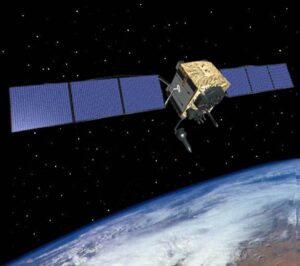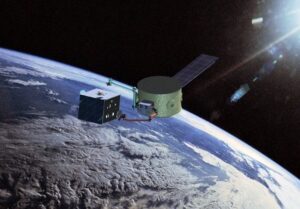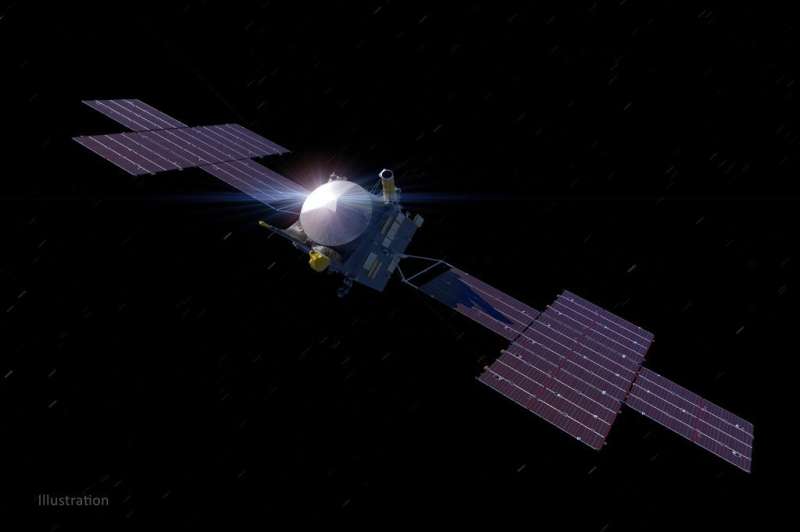FAA approves Launch Site Operator License for Spaceport Camden
Tuesday, 21 December 2021 03:06 Camden County, Georgia, a rocket testing location and alternate launch site for the Apollo program, has reclaimed its aerospace heritage with the issuance of a launch site operator license (LSOL) by the Federal Aviation Administration for Spaceport Camden. Spaceport Camden is a multiuser, vertical lift, commercial launch site on the Atlantic seaboard that will support up to 12 small vehicle laun
Camden County, Georgia, a rocket testing location and alternate launch site for the Apollo program, has reclaimed its aerospace heritage with the issuance of a launch site operator license (LSOL) by the Federal Aviation Administration for Spaceport Camden. Spaceport Camden is a multiuser, vertical lift, commercial launch site on the Atlantic seaboard that will support up to 12 small vehicle laun Comets' heads can be green, but never their tails
Tuesday, 21 December 2021 03:06 Every so often, the Kuiper Belt and Oort Cloud throw galactic snowballs made up of ice, dust and rocks our way: 4.6-billion-year-old leftovers from the formation of the solar system.
These snowballs - or as we know them, comets - go through a colourful metamorphosis as they cross the sky, with many comets' heads turning a radiant green colour that gets brighter as they approach the Sun.
Every so often, the Kuiper Belt and Oort Cloud throw galactic snowballs made up of ice, dust and rocks our way: 4.6-billion-year-old leftovers from the formation of the solar system.
These snowballs - or as we know them, comets - go through a colourful metamorphosis as they cross the sky, with many comets' heads turning a radiant green colour that gets brighter as they approach the Sun. Looking Back, Looking Forward To New Horizons
Tuesday, 21 December 2021 03:06 New Horizons remains healthy and continues to send valuable data from deep in the Kuiper Belt - more than 5 billion miles away - even as it speeds farther and farther from the Earth and Sun.
As 2021 winds down, I want to recount what the New Horizons project has accomplished this year, and also look ahead to tell you about our plans for 2022.
During a busy and productive 2021, our sc
New Horizons remains healthy and continues to send valuable data from deep in the Kuiper Belt - more than 5 billion miles away - even as it speeds farther and farther from the Earth and Sun.
As 2021 winds down, I want to recount what the New Horizons project has accomplished this year, and also look ahead to tell you about our plans for 2022.
During a busy and productive 2021, our sc 'Cyborg' artist who 'hears' colour turns to time travel
Tuesday, 21 December 2021 03:06 For Neil Harbisson, a self-described "cyborg" artist living near Barcelona, colour is quite literally music to his ears thanks to an antenna he designed to overcome colour blindness.
Well-known in Spain and with an international following that enabled him to meet the likes of Leonardo di Caprio and Tom Cruise, Harbisson is now testing out a new device designed to feel physically the passing
For Neil Harbisson, a self-described "cyborg" artist living near Barcelona, colour is quite literally music to his ears thanks to an antenna he designed to overcome colour blindness.
Well-known in Spain and with an international following that enabled him to meet the likes of Leonardo di Caprio and Tom Cruise, Harbisson is now testing out a new device designed to feel physically the passing Could acid-neutralizing life-forms make habitable pockets in Venus' clouds?
Tuesday, 21 December 2021 03:06 It's hard to imagine a more inhospitable world than our closest planetary neighbor. With an atmosphere thick with carbon dioxide, and a surface hot enough to melt lead, Venus is a scorched and suffocating wasteland where life as we know it could not survive. The planet's clouds are similarly hostile, blanketing the planet in droplets of sulfuric acid caustic enough to burn a hole through human s
It's hard to imagine a more inhospitable world than our closest planetary neighbor. With an atmosphere thick with carbon dioxide, and a surface hot enough to melt lead, Venus is a scorched and suffocating wasteland where life as we know it could not survive. The planet's clouds are similarly hostile, blanketing the planet in droplets of sulfuric acid caustic enough to burn a hole through human s A gigantic lane made of raw material for new stars
Tuesday, 21 December 2021 03:06 A group of astronomers, led by researchers from the Max Planck Institute for Astronomy (MPIA), have identified one of the longest known structures in the Milky Way. It stretches some 3900 light-years and consists almost entirely of atomic hydrogen gas. This filament, called "Maggie", could represent a link in the matter cycle of the stars. Analysing the measurements suggests that the atomic gas
A group of astronomers, led by researchers from the Max Planck Institute for Astronomy (MPIA), have identified one of the longest known structures in the Milky Way. It stretches some 3900 light-years and consists almost entirely of atomic hydrogen gas. This filament, called "Maggie", could represent a link in the matter cycle of the stars. Analysing the measurements suggests that the atomic gas Dragon delivery - European science destined for space
Tuesday, 21 December 2021 03:06 The next SpaceX resupply vehicle is packed with European science, ready for delivery to the International Space Station just in time for Christmas.
The Dragon spacecraft is scheduled to launch from NASA's Kennedy Space Center in Florida, USA, at 11:06 CET (10:06 GMT) Tuesday 21 December. But before it does, we take a quick peek at some of the European cargo it carries.
b>Safe air br
The next SpaceX resupply vehicle is packed with European science, ready for delivery to the International Space Station just in time for Christmas.
The Dragon spacecraft is scheduled to launch from NASA's Kennedy Space Center in Florida, USA, at 11:06 CET (10:06 GMT) Tuesday 21 December. But before it does, we take a quick peek at some of the European cargo it carries.
b>Safe air br Research into ageing set to blast into space
Tuesday, 21 December 2021 03:06 Scientists at the University of Liverpool, funded by the UK Space Agency, are using space to understand what happens to human muscles as we age, and why.?
When astronauts spend time in space, without the effects of gravity, their muscles get weaker, just as they do in older age, before recovering when they return to Earth. By studying what happens to muscle tissue in space, the team can co
Scientists at the University of Liverpool, funded by the UK Space Agency, are using space to understand what happens to human muscles as we age, and why.?
When astronauts spend time in space, without the effects of gravity, their muscles get weaker, just as they do in older age, before recovering when they return to Earth. By studying what happens to muscle tissue in space, the team can co SPAINSAT NG program successfully passes Critical Design Review
Tuesday, 21 December 2021 03:06 The SPAINSAT NG programme has successfully passed another important milestone, the critical design review (CDR) of the payload and the complete satellite, including the CDR elements of the Pacis 3 partnership project with the European Space Agency (ESA). The review was declared successful after verifying the good progress of the tests performed on the development models of the X-band payload.
The SPAINSAT NG programme has successfully passed another important milestone, the critical design review (CDR) of the payload and the complete satellite, including the CDR elements of the Pacis 3 partnership project with the European Space Agency (ESA). The review was declared successful after verifying the good progress of the tests performed on the development models of the X-band payload. Kacific goes all-in on AWS to scale up delivery of its broadband internet
Tuesday, 21 December 2021 03:06 Kacific Broadband Satellites has announced that it is going all-in on Amazon Web Services (AWS) to scale up the delivery of its broadband internet for the rural regions of Southeast Asia and the Pacific. Kacific plans to migrate its IT infrastructure and critical business applications to AWS by 2022.
AWS has enabled Kacific to reduce time-to-market and to enhance network management by appr
Kacific Broadband Satellites has announced that it is going all-in on Amazon Web Services (AWS) to scale up the delivery of its broadband internet for the rural regions of Southeast Asia and the Pacific. Kacific plans to migrate its IT infrastructure and critical business applications to AWS by 2022.
AWS has enabled Kacific to reduce time-to-market and to enhance network management by appr Boeing wins $329 million contract to support orbiting GPS satellites
Monday, 20 December 2021 23:11
The U.S. Space Force awarded Boeing a $329.3 million contract to support operations of Global Positioning System satellites for the next 10 years.
U.S. Defense Innovation Unit selects Maxar to produce robotic arms for on-orbit servicing
Monday, 20 December 2021 22:21
Maxar Technologies won a $9.3 million Defense Department contract to design and deliver two in-space servicing robotic arms for the Defense Innovation Unit.
How NASA's Psyche mission will explore an unexplored world
Monday, 20 December 2021 20:44
Launching in August 2022 and arriving at the asteroid belt in 2026, NASA's Psyche spacecraft will orbit a world we can barely pinpoint from Earth and have never visited.
The target of NASA's Psyche mission—a metal-rich asteroid, also called Psyche, in the main belt between Mars and Jupiter—is an uncharted world in outer space. From Earth- and space-based telescopes, the asteroid appears as a fuzzy blur. What scientists do know, from radar data, is that it's shaped somewhat like a potato and that it spins on its side.
By analyzing light reflected off the asteroid, scientists hypothesize that asteroid Psyche is unusually rich in metal. One possible explanation is that it formed early in our solar system, either as a core of a planetesimal—a piece of a planet—or as primordial material that never melted. This mission aims to find out, and in the process of doing so, they expect to help answer fundamental questions about the formation of our solar system.
Mynaric selected by DARPA to design next-generation optical terminals
Monday, 20 December 2021 20:38
Mynaric has been selected to participate in a DARPA program to develop next-generation laser communications terminals.
FAA license boosts Georgia spaceport, but more reviews ahead
Monday, 20 December 2021 19:45A federal agency on Monday granted a license for a launchpad that would fly commercial rockets from coastal Georgia.
The Federal Aviation Administration's approval of a launch site operator license for Spaceport Camden marks a significant milestone for the Georgia space project, though many reviews and permits are needed before any rockets can actually launch.
A Camden County leader said Monday that the project propels Georgia into the space race that's seen civilians and celebrities flown into space in recent months.
"This once in a generation opportunity will provide a new frontier of economic prosperity for Camden, the region and the state of Georgia," Steve Howard, Camden County Administrator and Spaceport Camden executive project lead, said in a statement after the FAA's decision was announced.
"Georgia is part of the new space race, and we will become one of the leaders," Howard added.
Even with the license, the FAA says that more comprehensive reviews would be needed before any rockets can be launched.
In its 36-page decision released Monday, the FAA said it considered potential impacts to the climate and environment, public comments, and the agency's responsibility to encourage and promote commercial space launches by the private sector.
"Sea level rise and other climatological changes, such as increase in extreme weather events, may affect the spaceport in the coming years," the FAA wrote in its report.

